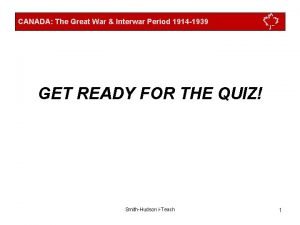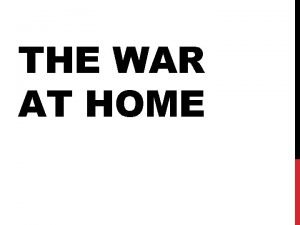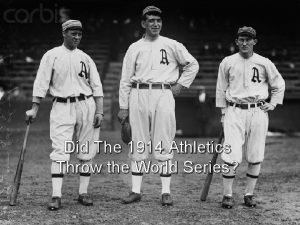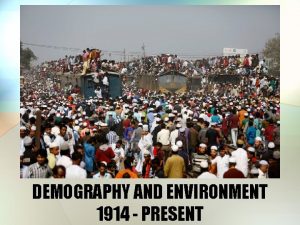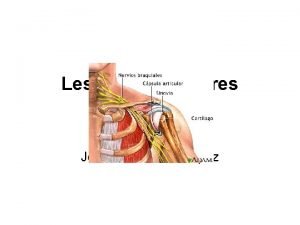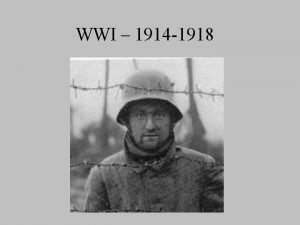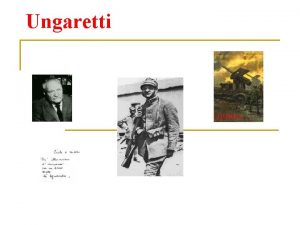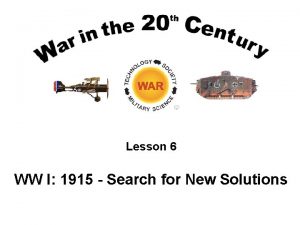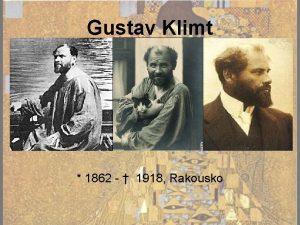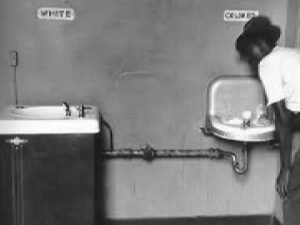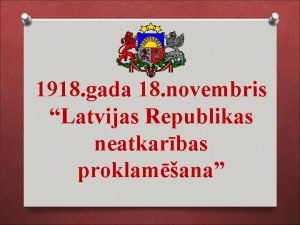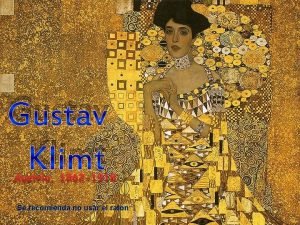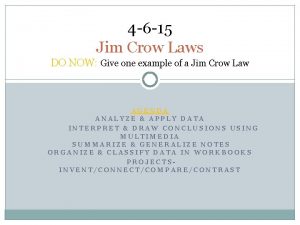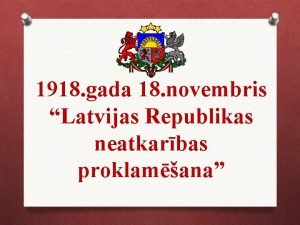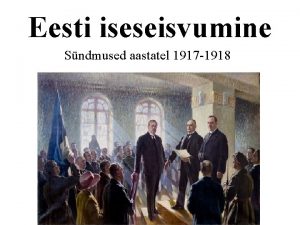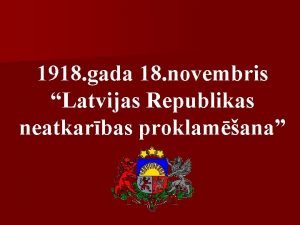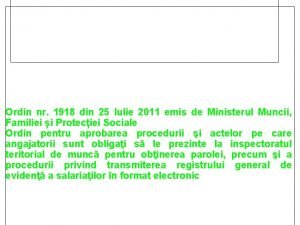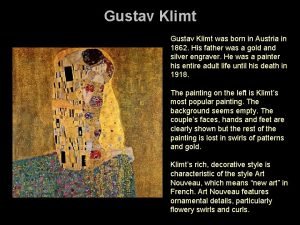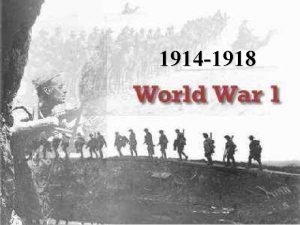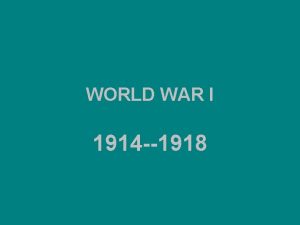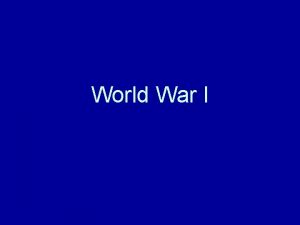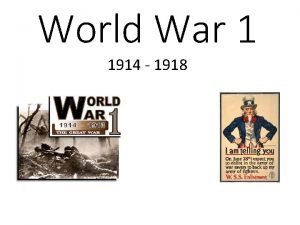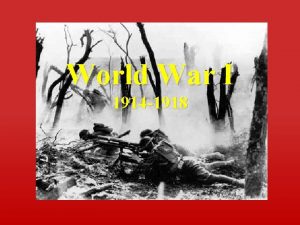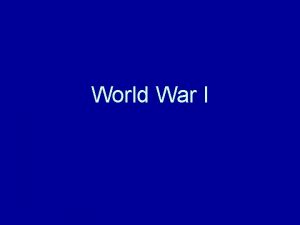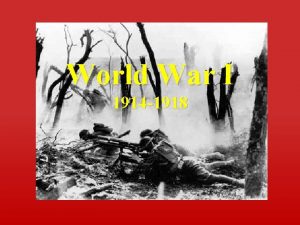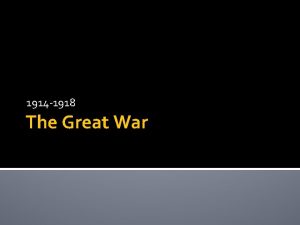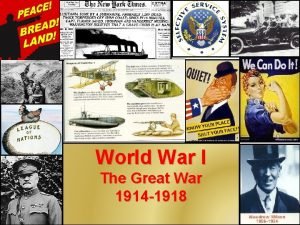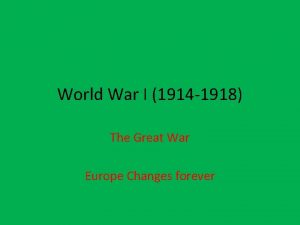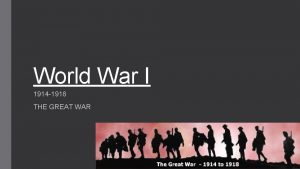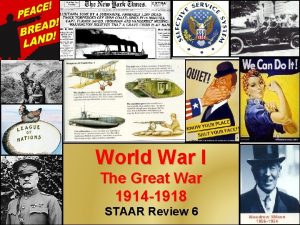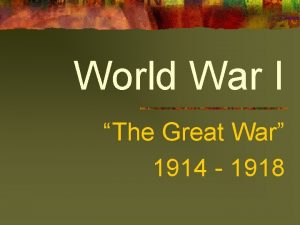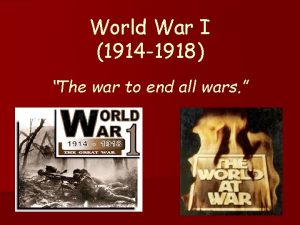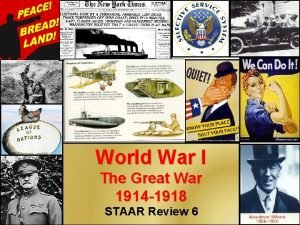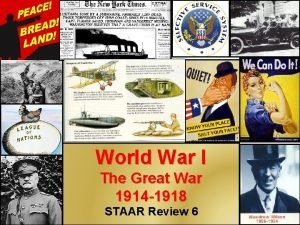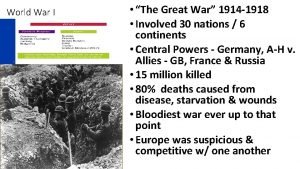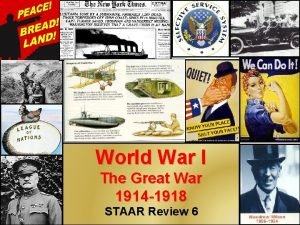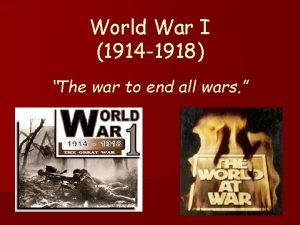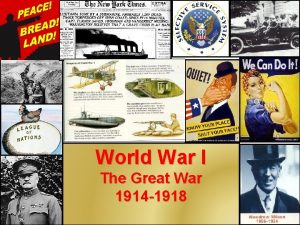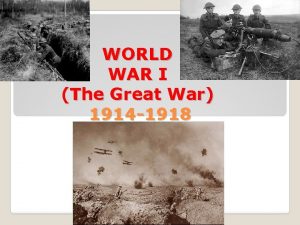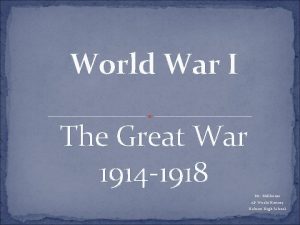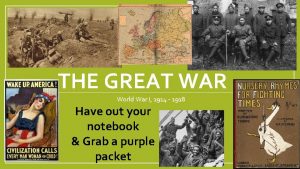World War I 1914 1918 Prof Ruthie Garca




















































- Slides: 52

World War I 1914 -1918 Prof. Ruthie García Vera AP US History

Long Term Causes of the War Ø Militarism: ilitarism the aggressive increase of military forces to intimidate and threaten other nations. Ø Alliance system: system by 1907 Europe was divided into two sides or armed alliances. Ø Imperialism: mperialism economic and political control over weaker nations Ø Nationalism: ationalism an extreme devotion to the interests and culture of its own people. 2

Colonial Competition • Some countries felt left out Asia ▫ Opium wars –spheres of influence ▫ Boxer rebellion • Colonization of Africa ▫ European colonies ▫ Rules of colonization made • The decline of the Ottoman Empire


• Ottomans entered war in 1915 on side of the Central Powers: ▫ They wanted to acquire Russian territory. ▫ Turkey slaughtered millions of Armenians to get their land. • Britain wanted to protect trade routes to India: They promised the Arabs their own country if they would join with Britain against the Ottomans.

Fundamental Rivalry q Between Germany and France: France antagonism reactivated by the defeat of the French in 1871 and the loss of Asancia-Lorraine to the German kingdom of Prussia. q Between Germany and England: England competition for industries, colonial policy on rearmament and maritime control. q Between Austria-Hungary and Russia: Russia the possession of the Balkans and the Slavs people.

Goals of each of the alliance members England Mantain the balance of power in continental Europe and its supremacy of the seas. France To limit the power of Germany. Russia To expand its territory towards the Mediterranean Sea. Germany Solidify German-speaking peoples and never fight on two fronts (West first and then East) Italy Unification of its own territory. Austria-Hungary To mantain the Empire united. Ottoman Empire Survive by conquering the Balcans.

Balkan Chaos The Serbs, Bosnians, Croats, and Slovenes all spoke similar languages and considered themselves one people, South Slavs, Slavs or Yugoslavs Only Serbia became independent from the Austro- Hungary Empire. The Yugoslavs wanted independence for its nations and when Austro-Hungary annexed Bosnia to their empire, Serbian nationalists decided to act.

Short term cause Assassination of Archduke Franz Ferdinand, heir of the Austro. Hungarian Empire. Balkan trigger Serbs revolted in the Balkans, backed by the Russians. Austria, in Bosnia, suppressed the Serbs. A Serbian killed the Austrian heir in Sarajevo, Bosnia. Franz Ferdinand, Archduke of Austria and his Wife Sophie, Duchess of Hohenberg one hour before their deaths, June 28, 1914. The assassination was the spark that ignited the war.

The Black Hand The main objective of the Black Hand was the creation, by means of violence, of a Greater Serbia. Its stated aim was: "To realize the national ideal, the unification of all Serbs. This organization prefers terrorist action to cultural activities; it will therefore remain secret. " The arrest of the serbian Gavrilo Princip.

The Domino Effect Austria declares war to Serbia Russia declares war to Austria Germany joins Austria France and England declares war to Austria and Germany.

Alliances and Strategies Central Powers Allies Triple Alliance Triple Entente • Germany • Russia • Austria-Hungary • France • Ottoman Empire • Great Britain • Bulgaria • Italy • Japan • United States (1917)

Italy joined the Triple Alliance but after the war broke out, it switched sides and went to fight with the Triple Entente. Turkey later joined the Triple Alliance. 13

The Great War q. Lasted 4 years, 3 months and 14 days Developed during the “Black Week” and all European nations, except Italy where involved one way or another. q. The death toll was terrible due to the Trench Warfare and the use of chemical arms and flamethrowers It was a Total War.

The Ottoman Empire joined the Central Powers through the secret Ottoman-German Alliance, Alliance which was signed on 2 August 1914. The main objective of the Ottoman Empire in the Caucasus was the recovery of its territories in Eastern Anatolia lost during the Russo-Turkish War in 1877 -78. Participating on the Allied side were Arabs who participated in the Arab Revolt, Revolt and Armenian militia who participated in the Armenian Resistance. The Armenian volunteer units and Armenian militia formed the Armenian Corps of the Democratic Republic of Armenia in 1918. This theatre encompassed the largest territory of all theatres of the war.

Phases of the War Germany invades France through Belgium ( neutral) to reach Paris. (Shlieffer Plan ) France stopped Germany in the battle of Marne Germany counter-attacks in the battle of Verdum without success because of Allied intervention. On the eastern front, the Russians face the Germans and reach the border of the Austrian Empire.

In the battle of the Somme (July to November 1916) the British lost 60, 000 soldiers in one day. At the end of the battle 1. 2 million soldiers had been killed to protect 7 miles of territory. These battles in the trenches lasted three years and gained little territory for both sides.

Trench Warfare • Technology superior to tactics ▫ Soldiers had to fight against the enemy, the dirt, the flooding and the humidity from the rain, the poison gas and the diseases from the corpses. It was a "No man's land“. • Very high death rates ▫ Battle of the Somme = 600, 000 allied and 500, 000 German dead for 125 miles of land. ▫ Battle of Verdun = 700, 000 killed on both sides with no gain in territory.

Many weapons evolved during the conflict: q q Flamethrowers War tanks Toxic Gas Repetition Machine Guns Airplanes were first used as weapons of war, emerging the aerial warfare France and United States manufactured aircraft for military purposes.

Flying Aces Manfred Albrecht Freiherr von Richthofen (2 May 1892 – 21 April 1918) was a German fighter pilot known as the "Red Baron". Baron He was the most successful flying ace of World War I, being officially credited with 80 confirmed air combat victories. He was killed in combat with Canadian pilots near the Somme River.

The British Vickers Machine Gun required a six man team to operate. One to fire, one to feed the ammunition, and the rest to help carry the weapon and supplies.

The major participants in the race were Britain and Germany, tying in with the concept of n Naval Arms Race The Dreadnought was the most heavily-armed ship in history. It was also faster than any other warship. The introduction of this new warship resulted in an arms race between Britain and Germany By 1914 the British had nineteen Dreadnoughts and thirteen under construction, compared with Germany's thirteen and seven under construction. Other fleets that had them at sea by 1914 were United States eight, France eight, Japan four, Austria-Hungary two and Italy one.

British Mark I tank on September 26, 1916

Australian troops in the trenches equipped with gas masks, Battle of Ypres, 1917 Mustard gas burns.

United States Neutrality United States was neutral during the first two years of the war. They traded with both alliances in Europe and their economy grew. They sold dynamite, gunpowder, submarines pipes and copper wire and other war materials President Wilson wanted to keep the country out of the war.

Reasons for Neutrality Central Powers • 11 million German. Americans • Irish-Americans hated Great Britain Allies • Close cultural ties to other allies • American, England, and France’s economies were increasingly interdependent. US Exports to Both Sides 26

America was Isolationist. The Monroe Doctrine (1823) sought to isolate “the American continents” from European influences and problems. In this cartoon, “The Great Wall” (1914), (1914) the Monroe Doctrine is shown as a protective shield for the United States.

British Control of Propaganda q Great Britain cut the transatlantic telegraph cable from Europe to the United States, controlling most war news to their own interest. q Companies in the East Coast had business ties with Allied countries. q Many American banks began to invest and make huge loans to cashhungry Allies. q Other American banks lent millions to Germany, even against the approval of the secretary of Treasury, a pro-British. q The economic prosperity of the United States depended on the outcome of the war: if the Allies won, the money loaned would be paid back; if not, the money was lost forever.

Why did the U. S. get involved? Blockades Britain blockaded (stopped) all German ships going to America. HMS Renown seen from another British warship (circa 1917) May, 1915: Germany told Americans to stay off British ships, because they could and would sink them.

Germany torpedoed the Lusitania, Lusitania sinking it with 1, 200 passengers and crew (including 128 Americans). It was eventually found to be carrying 4, 200 cases of ammunition. 30

Unlimited Submarine Warfare In March 1916 a U Boat sank the French passenger ship Sussex, Sussex killing some Americans. Wilson demanded Germany to abandon the use of submarine warfare in the “Sussex Pledge” A British ship torpedoed by a German U-boat In 1917, Germany announced “unlimited submarine warfare” in the war zone. Otherwise, Germany’s blockade would not be successful. Submarines: 31 German U-Boat U-14

The Zimmerman Note The U. S. intercepted a note from Zimmerman, the German ambassador in Mexico. It promised to give Texas, New Mexico, and Arizona back to Mexico in return for an alliance and attacking the United States. 32 The decoded Zimmerman Telegram

The Zimmerman Note and the sinking of six unarmed American ships led to a declaration of war. On April 2, 1917 Wilson declared in Congress: “the world must be made safe for democracy”. On April 6, after debate in both House and Congress, Wilson signed the resolution. New York Journal (4/7/1917) announcing the declaration of war. 33 America was at war.

Convincing the American People Idealism: Posters were used as propaganda and helped to convince the American people that the war was a good idea. 34

Idealism: 2 Goals For War 1. Wilson had to convince American that this would be the “War to End All Wars. ” 2. He had to convince American that beating the Germans and its allies would make the world safe for democracy. On Christmas Eve 1914, German and English soldiers stopped fighting to celebrate Christmas. It started when German troops decorated their trenches and began singing Christmas Carols. British troops opposite them began singing English Christmas Carols. The singing soon turned to shouts of Christmas cheer across the lines, eventually causing the troops to cross the No Man’s Land between the trenches. The two sides began to exchange small gifts between each other.

Idealism: The Fourteen Points President Wilson’s Fourteen Points was his vision for the future after the war, including freedom of the seas and a League of Nations to work for world peace. 36 President Woodrow Wilson

Russian Revolution • Unhappiness with the war among the Russian people ▫ Germany/Austria beating Russians Calling for a Communist revolution, anti-Tsarist protesters gather outside the Winter Palace in Petrograd, Russia, February 1917.

There was a change in the Government towards a democratic one moderated by the revolution of the Mensheviques The Bolsheviks of Vladimir Lenin overthrow the democratic Government, establishing a Communist Government. Russia withdraws from the war after signing the Treaty of Brest-Litovsk with Germany, in 1917, giving it Poland Ukraine Russia’s withdrawal allowed Germany to fight a one -front war with all its troops concentrated on France.

End of the War § After the Central Powers were exhausted by the war, especially after the US began fighting, it sought an armistice, the end of fighting. § The Battle of Argonne broke German morale. § On November 3, 1918 the Austro-Hungarian Empire surrendered to the Allied forces.

On November 9, 1918 Kaiser Wilhelm II was forced to abdicate throne and Germany became a Republic. So in eleven in the morning, of the eleventh day of the eleventh month of 1918 Germany signed an armistice and the great war ended. Two month later 27 countries attended the peace conference at Versailles, directed by the “Big Four”, Four President Wilson, Wilso British Prime Minister David Lloyd George, George French Premier Clemenceau and Italian Prime The Great War ended Minister Vittorio Orlando on 11/11/1918

What ended the war? Peace Treaties 1. The Treaty of Saint-Germain was sign with Austria. • It dissolved the Austro Hungarian Empire and established nine new nations including Poland, Hungary, Chekoslovaquia, and Yugoslavia 2. The Treaty of Versailles was signed between the Allied powers and Germany. • It dismantled Germany’s military. • It forced Germany to make reparations and pay $33 billion in war damages and to return Asancia-Lorraine to France. 41

• It humiliated Germany and prevented the establishment of true peace in Europe. • German reaction was that they were treated too harsh because they felt justified in the war. • The guilt clause blamed Germany for the war. • This treaty so destroyed the German economy and the morale of the German people, that within 20 years, they would start another world war. • The Seeds of WWII were planted.

3. The Covenant of the League of Nations • It divided the Ottoman Empire, creating independent nations and mandates. • Armaments were to be reduced and protection guaranteed between members against aggressions. • Colonies of the Central Powers became protectorates of the League. President Wilson gave in to many of his fourteen points in exchange for support of the league. The United States Congress did not agree to ratify the treaty and negotiated separate peace treaties with each central power.


Men Killed in Battle Approximate Comparative Losses in World War I

Middle East Mandates After Britain's declaration of war on the Ottoman Empire in November 1914, Zionist British cabinet member Herbert Samuel circulated a memorandum entitled “The Future of Palestine”, stating that the solution of the problem of Palestine would be the annexation of the country to the British Empire. The Balfour Declaration, dated 2 November 1917, was a letter from the United Kingdom's Foreign Secretary Arthur Balfour to Baron Rothschild, a leader of the British Jewish community, for transmission to the Zionist Federation of Great Britain and Ireland. Zionism: an international movement originally for the establishment of a Jewish national or religious community in Palestine and later for the support of modern Israel.

Balfour Declaration


How did the war affect the U. S. ? Women filled factory jobs. Woman served in the army in non combat positions. Women’s war effort helped bring about passage of the 19 th Amendment after the war giving women the right to vote. African Americans. Black soldiers still served in segregated units. In the “Great Migration” thousands of African Americans moved to the North to work in factories.

Wartime Agencies War Industries Board (WIB) Bernard Baruch- coordinated the production of war materials, allocated raw materials and factories and set prices. Food Administration Herbert Hoover- responsible for food production and reducing civilian consumption. It encouraged Victory Gardens and food rationing: Wheatless Mondays, Meatless Tuesdays, Porkless Thursdays left more food for the troops. National War Labor Board William Howard Taft- Prevented strikes from disrupting the war efforts.

What was the job of George Creel during the war? • Journalist Head of the Committee on Public Information 1917. • His job was to sell America the war. (Propaganda) • Tried to “whip” up support for Wilson’s ideas. • Help US raise money to fight. “There will be a creation of a passionate belief in the justice of America’s cause that would weld The American people into one white hot mass instinct. ” - George Creel

War’s Impact at Home Hatred of all things German spread across the U. S. For example “sauerkraut” was renamed “Liberty Cabbage. ” The Espionage Act 1917 and the Sedition Act of 1918 punished those against the war, many of whom were labor leaders. The end of the wartime economy led to fear of Communism, unemployment for the veterans, riots, inflation, labor strikes and racial tension. Adapted from Mc. Intyre at http: //worldhistory. pppst. com class notes and other internet sources. RGV
 1914 1918
1914 1918 Edna house on mango street
Edna house on mango street Who reorganized the war industries board in 1918
Who reorganized the war industries board in 1918 Pstuffy bunny
Pstuffy bunny World population in 1914
World population in 1914 Andrea garca
Andrea garca Andrea garca
Andrea garca A mayor conocimiento mayor sufrimiento
A mayor conocimiento mayor sufrimiento Jorge garca
Jorge garca Ricardo garca
Ricardo garca Colorado garca
Colorado garca Garca la carolina
Garca la carolina 13 linhas para viver
13 linhas para viver Repuestos garca
Repuestos garca Ricardo garca
Ricardo garca Miguel garca
Miguel garca Ricardo garca
Ricardo garca Rhizomer
Rhizomer Definicion de garca
Definicion de garca Solidificação
Solidificação Garça tipos
Garça tipos Definicion de garca
Definicion de garca Garca la carolina
Garca la carolina Gabriel garca
Gabriel garca 13 conseil de la vie
13 conseil de la vie Sergio garca
Sergio garca Gabriel garca
Gabriel garca Map of europe in 1918
Map of europe in 1918 Mapa ukrainy 1918
Mapa ukrainy 1918 Nspesso
Nspesso Varför kallas perioden 1918-1939 för mellankrigstiden?
Varför kallas perioden 1918-1939 för mellankrigstiden? Ft17
Ft17 1918-1862
1918-1862 Jim crow (character)
Jim crow (character) 1918 18 novembris
1918 18 novembris What is the red scare
What is the red scare 1877 to 1918 cloze notes
1877 to 1918 cloze notes Proiect educational de 1 decembrie
Proiect educational de 1 decembrie 1918-1862
1918-1862 1918-1862
1918-1862 1918-1862
1918-1862 Louisiana 1918 poll tax receipt
Louisiana 1918 poll tax receipt 1918 18 novembris
1918 18 novembris 11 listopada 1918 piosenka tekst
11 listopada 1918 piosenka tekst 1918-1862
1918-1862 Jaan poska
Jaan poska 1918 18 novembris
1918 18 novembris Gustv klimt
Gustv klimt Palestina 1918
Palestina 1918 Revisal hg 500 din 2011 download
Revisal hg 500 din 2011 download Lịch sử hà nội từ năm 1802 đến năm 1918
Lịch sử hà nội từ năm 1802 đến năm 1918 1918-1862
1918-1862 1918-1862
1918-1862
